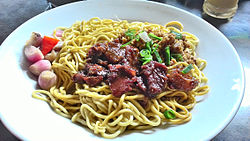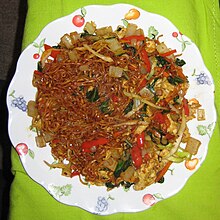Bakmi
 Bakmitopped with pork | |
| Alternative names | Bami,bakmie |
|---|---|
| Type | Noodle |
| Course | Main dish |
| Place of origin | Indonesia,derived from theChinese noodle[1] |
| Region or state | Indonesia,Thailand,Singapore,Laos,Suriname,Belgiumand theNetherlands |
| Serving temperature | hot |
| Main ingredients | Wheat flour,ground pork,soy sauce |

Bakmi(Javanese:ꦧꦏ꧀ꦩꦶ,romanized:bakmi) orbami(Thai:บะหมี่,pronounced[bā.mìː],Lao:ບະໝີ່,pronounced[bā.mīː]) is a type ofwheatbased noodles derived fromChinesecooking tradition. It was brought toIndonesia[1]byChinese immigrantsfrom Southern Chinese provinces likeFu gian.It is typically prepared seasoned insoy sauceand topped withporkproducts, which is often substituted for other protein sources in predominantly MuslimIndonesia.Chinese-style wheat noodles has become one of the most common noodle dishes, especially inSoutheast Asiancountries which have significant Chinese populations and known by various names.
Chinese-style wheat noodles is known asbakmiin Indonesia, where it has been adapted to more closely align with the local tastes and adapted inJavaneseandIndo cuisine.Bakmiis between Chinese style wheat noodles and Japaneseudonsin thickness, and there are several variants ofbakmiinIndonesia.The namebakmiliterally translates to "meat noodle", where meat includeschickenandbeef.
In Indonesia, especially in large urban areas such as Jakarta, Medan and Surabaya, there are numbers ofwarungsfood stalls, restaurants and eateries that specialised on serving this type of noodle dish. Each of these noodle place differentiate their wares with specialities of ingredients and variations of toppings.[2]
Origin and history
[edit]Bakmiconsists of twoHokkienChinese words, which literally translates to English as "meatnoodles"(ThịtMặt,Pe̍h-ōe-jī:bah-mī).
Chinese influences is evident inIndonesian food,such asbakmi,mie ayam,pangsit,mie goreng,andkwetiau goreng.[3]The wordsmieandbami,used inDutch,come frombakmiand were introduced into theDutch languageduring theDutch colonial period in Indonesia.Indonesian food is very popular in theNetherlands,andbami goreng(friedbakmi) is a popular dish.
InThailand,wheat-based egg noodles are known asbami,which may be ordered asbami namorbami haeng(egg noodles with soup and without soup respectively), and the noodles may be used in Chinese style stir-fried dishes.[4]
In thePhilippines,there is a similar noodles dish calledPancit Bam-i or Pancit Mami,where it is calledbam-iinCebuano Bisaya,[5]ormami / bamiinTagalog(Filipino).[6][7]
Ingredients
[edit]Bakmiorbamiis a type ofwheatnoodle with a slightly pale yellow colour. The most common type ofbakmiin Indonesia ismi kuningor 'yellow noodles' made from finely ground wheat, sometimes enriched witheggsasmi telur(egg noodle) made into dough, ground and run through holes to create noodle strings. The traditional way to createbakmiis by pulling the dough several times coated withflourto create the noodle strings, similar to the method to makelamian.
The most common recipe ofbakmidish in Indonesia uses chicken meat as the majority of Indonesians areMuslims.Chicken noodle (Indonesian:bakmie ayam or mie ayam),mie ayamis wheat noodle topped with diced chicken meat seasoned in soy sauce.Mie ayamoften accompanied withwonton(Indonesian:pangsit) either crispy fried or in soup, and alsobakso(meatball).Bakmi ayamis a popularChinese Indonesiandish and ubiquitous in Indonesian cities, it can be served in a restaurant to a humble travelling cart. The other popular Indonesianbakmirecipe is friedbakmi(Indonesian:bakmie gorengorIndonesian:mie goreng).
Preparation
[edit]Bakmiis normally boiled for serving. Whenbakmiis intended for use in soup, it is usually boiled separately from the broth. The noodles are usually mixed with animal fats, either from pork, chicken or beef. The noodles are then served with various toppings: an example would include a few slices ofchar siu( xá xíu ) or barbecued pork, with addition of Chinese green vegetables and a bowl ofbroth.
In Indonesia, the most common toppings are diced seasoned chicken withchoy sumand fried wonton skin, to a more complete version served with fried or boiled wonton andbakso(meatballs).[8]The soup is served in a different bowl, and is added to the noodles by the individual diner according to taste. Several notable Indonesian dishes developed from the original Chinese wheat noodle tradition includesmie ayam(chicken noodle) andmie goreng(stir fried noodle insweet soy sauce).I fu mieisbakmithat is first deep fried and then topped with a thickened gravy of vegetables and meat.
Varieties
[edit]Indonesian
[edit]
- Bakmi bangka,aChinese Indonesian noodle dishfromBangka Island.Noodles are topped with minced pork, slices of braised pork, mushroom and chopped scallion.[9]The original Chinese Indonesian version uses minced pork; thehalalversion, however, usually uses minced chicken.[10]
- Bakmi siantar,pork noodle fromPematang Siantartown in North Sumatra, usually served with redchar siucoloured withangkak.Popular withinBatak cuisine,it was derived from, and possibly the most closer version to the traditionalChinese Indonesianbakmi(meat/pork noodle).[11]
- Bakmi ayam,Indonesian Chinese chicken noodles.
- Bakmi goreng,Indonesian Chinese fried noodles, omnipresent in Indonesia.
- Bakmi jawa,from Central and EastJavawith somewhat wet consistency.
- Bakmi aceh,fromAceh;it has a curry-like flavor.
- Bakmi celor,fromPalembang;it has a sweet starchy gravy.
- Bakmi pangsit,generally known fromSumateraarea,North Sumatera,Medan,etc.
- Bakmi belitung,fromBelitungisland, with sweet white sauce.
- Bakmi kangkungis composed of noodles,kangkung,bean sprouts, lime juice, minced meat, and broth.
Thailand
[edit]
- Bami haeng(Thai:บะหมี่แห้งเป็ด,a dish made with wheat noodles (bami) served "dry" (haeng).
- Bami mu daeng(Thai:บะหมี่หมูแดง), noodle dish withred roast pork.
- Khao soi(Thai:ข้าวซอย),Northern Thaicurry-soup dish which usesbaminoodles.[12]
See also
[edit]References
[edit]- ^ab"Sejarah Bakmie Indonesia".(Indonesian)
- ^Valentina, Jessicha (29 March 2019)."Jakpost guide to Tirta Lie's favorite 'bakmi' places".The Jakarta Post.Retrieved2024-06-23.
- ^Heinz Von Holzen (2014).A New Approach to Indonesian Cooking.Marshall Cavendish International Asia Pte Ltd. p. 15.ISBN9789814634953.Retrieved15 February2016.
- ^Thapanachai, Somporn."A shared history".Bangkok Post.RetrievedApril 16,2021.
- ^"Cebuano Dictionary: bam-i".Pinoy Dictionary.RetrievedMay 22,2023.
- ^"Tagalog Dictionary: mami".Pinoy Dictionary.RetrievedMay 22,2023.
- ^"Tagalog Dictionary: bami".Pinoy Dictionary.RetrievedMay 22,2023.
- ^Wirajuda, Tunggul (8 September 2022)."Savoring nostalgic bowls of noodles at Bakmi Gondangdia Lama".The Jakarta Post.Retrieved2024-06-23.
- ^Media, Kompas Cyber."Cara Membuat Bakmi Bangka, Praktis!".KOMPAS(in Indonesian).Retrieved2020-07-15.
- ^Media, Kompas Cyber."Cari Bakmi Bangka Halal di Jakarta? Yuk ke Bakmi Bangka 777 Aloiy Halaman all".KOMPAS(in Indonesian).Retrieved2020-07-15.
- ^"Penjualnya Cantik, Masyhurnya Bakmi Siantar Lina Hingga Terkenal Sampai Tangerang".Tribun Medan(in Indonesian).Retrieved2020-07-15.
- ^"Use Your Noodle: A Primer On Thai Noodles".Michelin.November 8, 2020.RetrievedApril 16,2021.
